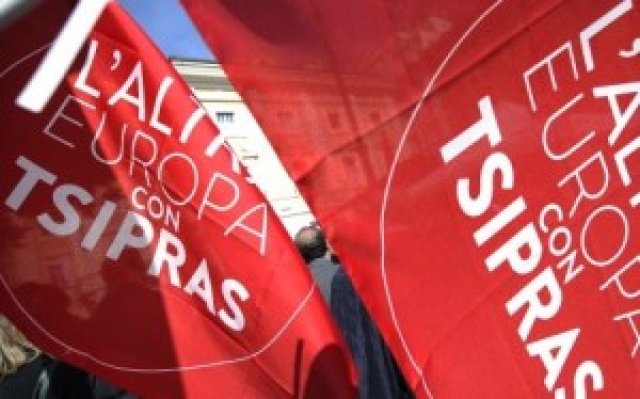
The project is called “The Different Europe with Alexis Tsipras”. It name is written on a red background. Predictions indicate it could surpass, maybe easily, the 4% electoral threshold needed to win seats in the coming European elections.
In 2009, this threshold prevented both left lists, the Communist Refoundation Party (PRC) and the Left Ecology Freedom (SEL), both of which received only a little more than 3%, from winning seats.
This new project, however, is not a mere electoral coalition set up to clear this hurdle. In its foundation and structure it is something very different.
First of all, this project was founded as an act of solidarity with the struggles of Alexis Tsipras and Greece's Coalition of the Radical Left (SYRIZA).
In the course of the 12 months before the announcement of Tsipras's candidacy for president of the European Commission, the young leader of the Greek Left gained support in many different parts of Italy.
It was suggested that his candidacy for the presidency of the European Commission could represent an important step in the overall struggle against austerity and in fighting for a different Europe.
A number of politicians said so, but also important intellectuals expressed their appreciation for Tsipras. One was Barbara Spinelli, editorialist and daughter of well-known Italian political theorist Altiero Spinelli
The PRC formalised support for Tsipras's candidacy, which was decided on and launched by the Party of the European Left in the course of its congress in Madrid in December. In the meantime, a group of intellectuals took the initiative to contact Tsipras to ask him to support their idea of putting him forward as the candidate of a grassroots movement that was mainly an expression of citizens and social movements.
The intellectuals mentioned the difficulties within the Italian left, its weaknesses and fragmentation, as well as the need for a new start from the grassroots.
Some points they included worth debating, such as the difference between the concept of a movement and citizens’ participation, and what is entailed in setting up as a political party. Also, we cannot deny that there are many differing emphases and opinions.
The glue that holds all this together is putting the topic of Europe at the centre, as well as the emotional connection with Tsipras’ and the people’s struggle against austerity and the fight for a different Europe.
It is a connection with a just struggle to which a contribution needs to be made. If something good and new emerges from this legitimate struggle for the Italian left — even better.
This approach has initiated a process of unification not seen in Italy in a long time. It ultimately led to the SEL deciding, at its national congress, to part of the Tsipras list.
The list’s structure reflects, to a great extent, respect for the initial idea of putting the European struggle at the centre. It mainly puts forward candidates well known for leading struggles and for their critical thinking.
Also, some obligatory rules have been formulated, such as the one of not putting forward anyone as a candidate who has been a member of legislative assemblies or held government or political responsibilities at the top level in the past 10 years.
This is a very strict rule. It does not aim to penalise any of our comrades, but rather is a bid to take our responsibility to overcome the problems facing the left seriously. Also, such a rule favours new candidates.
We have an equal number of male and female candidates, many of whom are involved in significant social movements. They include workers and those who are active in the cultural sector.
There are also representatives of parties, but a limited number and in all cases they have a connection to struggles.
Of course, not everything is running smoothly. We face many problems. These include discussions about the relationship between the list and the different parties. There is also some debate about the names selected for the list.
Clearly, some mistakes have been made as well. But time was a big factor owing to the absurd Italian electoral law that requires new lists to collect more than 150,000 signatures, with a quota of 3000 in very small regions such as the Valle d’Aosta.
This has called for a huge effort which, nevertheless, has been met with great enthusiasm by many activists who are being mobilised by the Tsipras list and who find a great echo at many information stands all over Italy, equipped with red flags; the list’s symbol.
They represent a signal that tells us that we can make it, that the Italian left cannot only return to the European parliament to back up Tsipras in fighting austerity, but contribute to the struggle for a different Europe and to regenerate — we hope — our own force and unity.
Along with with collecting signatures, we will follow ongoing and newly emerging struggles. This includes against the Transatlantic Trade and Investment Partnership between the US and the the European Union, which represents yet another terrible attack on democracy and our rights.
[Abridged from Transform! Network. Translated from Italian by Veronika Peterseil.]
